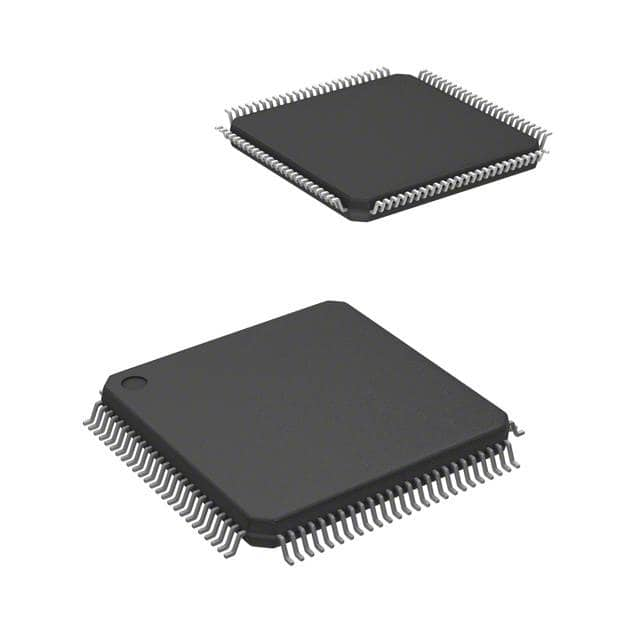Lihat spesifikasi untuk detail produk.

MSP430F47163IPZR
Product Overview
- Category: Microcontroller
- Use: Embedded systems, Internet of Things (IoT) devices, consumer electronics
- Characteristics: Low power consumption, high performance, integrated peripherals
- Package: 64-pin LQFP (Low-profile Quad Flat Package)
- Essence: Advanced microcontroller with a wide range of features and capabilities
- Packaging/Quantity: Available in tape and reel packaging, quantity varies based on customer requirements
Specifications
- Architecture: 16-bit RISC
- Clock Speed: Up to 16 MHz
- Flash Memory: 256 KB
- RAM: 16 KB
- Operating Voltage: 1.8V - 3.6V
- Digital I/O Pins: 48
- Analog Inputs: 16
- Serial Communication Interfaces: UART, SPI, I2C
- Timers: Multiple 16-bit timers
- ADC: 12-bit SAR ADC
- PWM Outputs: Multiple PWM channels
- Operating Temperature Range: -40°C to +85°C
Pin Configuration
The MSP430F47163IPZR has a total of 64 pins. The pin configuration is as follows:
- Pin 1: VCC
- Pin 2: P1.0
- Pin 3: P1.1
- ...
- Pin 64: GND
For a detailed pinout diagram, please refer to the datasheet provided by the manufacturer.
Functional Features
- Low power consumption: The MSP430F47163IPZR is designed for battery-powered applications, offering various power-saving modes and efficient power management.
- Integrated peripherals: The microcontroller includes a wide range of integrated peripherals such as UART, SPI, I2C, timers, ADC, and PWM outputs, providing flexibility for various applications.
- High performance: With a clock speed of up to 16 MHz and a powerful 16-bit RISC architecture, the MSP430F47163IPZR delivers high processing capabilities.
- Robust communication interfaces: The microcontroller supports multiple serial communication interfaces, enabling seamless connectivity with other devices and systems.
Advantages
- Low power consumption extends battery life in portable devices.
- Integrated peripherals reduce the need for external components, saving cost and board space.
- High-performance architecture enables efficient execution of complex tasks.
- Robust communication interfaces facilitate easy integration with other devices.
Disadvantages
- Limited flash memory and RAM may restrict the complexity of applications that can be implemented.
- Availability of alternative models with more features or higher specifications may limit the competitiveness of this specific microcontroller.
Working Principles
The MSP430F47163IPZR operates based on the principles of a 16-bit RISC architecture. It executes instructions stored in its flash memory, utilizing the integrated peripherals and resources to perform various tasks. The microcontroller interacts with external devices through its digital I/O pins and communication interfaces, enabling data exchange and control.
Application Field Plans
The MSP430F47163IPZR finds applications in various fields, including:
- Internet of Things (IoT) devices: The low power consumption and integrated peripherals make it suitable for IoT applications such as smart home devices, environmental monitoring systems, and wearable devices.
- Consumer electronics: The microcontroller can be used in consumer electronics products like remote controls, gaming consoles, and home appliances.
- Industrial automation: Its robust communication interfaces and high-performance architecture make it suitable for industrial automation applications, including control systems, motor drives, and sensor networks.
Alternative Models
- MSP430F47166IPZR: Similar to MSP430F47163IPZR but with increased flash memory and RAM capacity.
- MSP430F47169IPZR: Similar to MSP430F47163IPZR but with additional integrated peripherals and higher clock speed.
These alternative models offer enhanced capabilities and can be considered based on specific project requirements.
Note: The content provided above is a sample structure for an encyclopedia entry. The actual content may vary based on the specific product and its features.
Sebutkan 10 pertanyaan dan jawaban umum terkait penerapan MSP430F47163IPZR dalam solusi teknis
Sure! Here are 10 common questions and answers related to the application of MSP430F47163IPZR in technical solutions:
Q: What is MSP430F47163IPZR?
A: MSP430F47163IPZR is a microcontroller from Texas Instruments' MSP430 family, designed for low-power applications.Q: What are the key features of MSP430F47163IPZR?
A: Some key features include a 16-bit RISC architecture, ultra-low power consumption, integrated peripherals, and a wide operating voltage range.Q: What are some typical applications of MSP430F47163IPZR?
A: MSP430F47163IPZR is commonly used in battery-powered devices, IoT applications, sensor networks, industrial control systems, and portable medical devices.Q: How much flash memory does MSP430F47163IPZR have?
A: MSP430F47163IPZR has 120KB of flash memory for program storage.Q: Can I interface MSP430F47163IPZR with other devices?
A: Yes, MSP430F47163IPZR has various built-in peripherals like UART, SPI, I2C, ADC, and GPIOs that allow easy interfacing with external devices.Q: What is the maximum clock frequency of MSP430F47163IPZR?
A: The maximum clock frequency is 25 MHz, allowing for fast execution of instructions.Q: Does MSP430F47163IPZR support low-power modes?
A: Yes, MSP430F47163IPZR supports multiple low-power modes, enabling efficient power management and extending battery life.Q: Can I program MSP430F47163IPZR using C or assembly language?
A: Yes, MSP430F47163IPZR can be programmed using both C and assembly language, with various development tools and IDEs available.Q: What is the operating voltage range of MSP430F47163IPZR?
A: The operating voltage range is from 1.8V to 3.6V, making it suitable for both battery-powered and low-power applications.Q: Are there any development boards or evaluation kits available for MSP430F47163IPZR?
A: Yes, Texas Instruments offers development boards and evaluation kits specifically designed for MSP430F47163IPZR, providing a convenient platform for prototyping and testing.
Please note that these answers are general and may vary depending on specific requirements and use cases.

